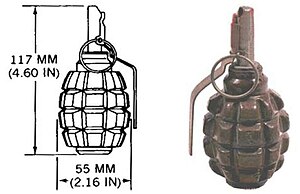F1 grenade (Russia)
| F1 anti-personnel hand grenade | |
|---|---|

F1 hand grenade
|
|
| Type | Hand grenade |
| Place of origin | Soviet Union |
| Service history | |
| In service | 1941–present (Russia) |
| Used by | Soviet Union, Brazil, China |
| Wars |
World War II Hukbalahap Rebellion Korean War Vietnam War Rhodesian Bush War Six-Day War Yom Kippur War Iraq War 2011 Libyan Civil War Syrian Civil War War in Donbass |
| Specifications | |
| Weight | 600 g |
| Length | 130 mm |
| Diameter | 55 mm |
|
|
|
| Filling | Trinitrotoluene |
| Filling weight | 60 g |
|
Detonation
mechanism |
Time delay fuse 3.2 to 4.2 s |
The Soviet F1 hand grenade, is an anti-personnel fragmentation defensive grenade. It is based on the French F1 grenade and contains a 60-gram explosive charge (TNT). The total weight of the grenade with the fuze is about 600 grams.
Due to its shape, it is nicknamed the limonka ("little lemon"). It is also nicknamed Efka (Russian: Эфка) for the letter F. It is similar to the American Mk2 grenade "Pineapple grenade", which was also ultimately modeled on the French F1.
The UZRGM (Universal'nyi Zapal, Ruchnaya Granata, Modernizirovannyi > “Universal Igniter, Hand Grenade, Improved") fuze is a universal Russian type also used in the RG-41, RG-42, RGO-78, RGN-86 and RGD-5 grenades. The standard time delay for this fuze is 3.5 to 4 seconds. However, UZRGM fuze variants are available which give delays between zero (i.e., instantaneous, specifically for use in booby-traps) and 13 seconds. It is possible to hear a loud "pop" as the fuze ignites and begins to burn. Additionally, it is possible to screw an MUV booby-trap firing device into the fuze well.
The F1 was introduced during World War II and subsequently redesigned post-war. It has a steel exterior that is notched to facilitate fragmentation upon detonation and to prevent hands from slipping. The distance the grenade can be thrown is estimated at 30–45 meters. The radius of the shrapnel dispersion is up to 200 meters (effective radius is about 30 meters, by some sources (Russian)). Hence, the grenade has to be deployed from a defensive position to avoid harm.
...
Wikipedia
